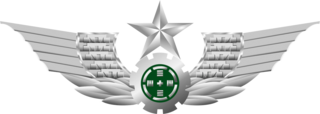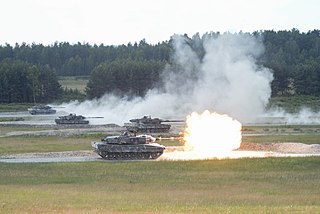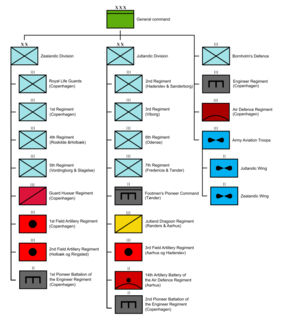
Mechanized infantry are infantry units equipped with armored personnel carriers (APCs) or infantry fighting vehicles (IFVs) for transport and combat.

A tank is an armoured fighting vehicle intended as a primary offensive weapon in front-line ground combat. Tank designs are a balance of heavy firepower, strong armour, and good battlefield mobility provided by tracks and a powerful engine; usually their main armament is mounted in a turret. They are a mainstay of modern 20th and 21st century ground forces and a key part of combined arms combat.

Tactical communications are military communications in which information of any kind, especially orders and military intelligence, are conveyed from one command, person, or place to another upon a battlefield, particularly during the conduct of combat. It includes any kind of delivery of information, whether verbal, written, visual or auditory, and can be sent in a variety of ways. In modern times, this is usually done by electronic means. Tactical communications do not include communications provided to tactical forces by the Defense Communications System to non-tactical military commands, to tactical forces by civil organizations, nor does it include strategic communication.
Military tactics encompasses the art of organizing and employing fighting forces on or near the battlefield. They involve the application of four battlefield functions which are closely related – kinetic or firepower, mobility, protection or security, and shock action. Tactics are a separate function from command and control and logistics. In contemporary military science, tactics are the lowest of three levels of warfighting, the higher levels being the strategic and operational levels. Throughout history, there has been a shifting balance between the four tactical functions, generally based on the application of military technology, which has led to one or more of the tactical functions being dominant for a period of time, usually accompanied by the dominance of an associated fighting arm deployed on the battlefield, such as infantry, artillery, cavalry or tanks.
Military science is the study of military processes, institutions, and behavior, along with the study of warfare, and the theory and application of organized coercive force. It is mainly focused on theory, method, and practice of producing military capability in a manner consistent with national defense policy. Military science serves to identify the strategic, political, economic, psychological, social, operational, technological, and tactical elements necessary to sustain relative advantage of military force; and to increase the likelihood and favorable outcomes of victory in peace or during a war. Military scientists include theorists, researchers, experimental scientists, applied scientists, designers, engineers, test technicians, and other military personnel.

Motorized infantry is infantry that is transported by trucks or other motor vehicles. It is distinguished from mechanized infantry, which is carried in armoured personnel carriers or infantry fighting vehicles, and from light infantry, which can typically operate autonomously from supporting elements and vehicles for relatively long periods and may be airborne.
AirLand Battle was the overall conceptual framework that formed the basis of the US Army's European warfighting doctrine from 1982 into the late 1990s. AirLand Battle emphasized close coordination between land forces acting as an aggressively maneuvering defense, and air forces attacking rear-echelon forces feeding those front line enemy forces. AirLand Battle replaced 1976's "Active Defense" doctrine, and was itself replaced by "Full Spectrum Operations".
Maneuver warfare, or manoeuvre warfare, is a military strategy which seeks to shatter the enemy's overall cohesion and will to fight.

The People's Liberation Army Ground Force is the land-based service branch of the People's Liberation Army and the largest and oldest branch of the entire Chinese armed forces. The PLAGF can trace its lineage from 1927 as the Chinese Red Army; however, it was not officially established until 1948.

Armoured warfare or armored warfare, is the use of armored fighting vehicles in modern warfare. It is a major component of modern methods of war. The premise of armoured warfare rests on the ability of troops to penetrate conventional defensive lines through use of manoeuvre by armoured units.
Deep operation, also known as Soviet Deep Battle, was a military theory developed by the Soviet Union for its armed forces during the 1920s and 1930s. It was a tenet that emphasized destroying, suppressing or disorganizing enemy forces not only at the line of contact but also throughout the depth of the battlefield.
Ground warfare or land warfare is the process of military operations eventuating in combat that takes place predominantly on the battlespace land surface of the planet.

Military organization or military organisation is the structuring of the armed forces of a state so as to offer such military capability as a national defense policy may require. In some countries paramilitary forces are included in a nation's armed forces, though not considered military. Armed forces that are not a part of military or paramilitary organizations, such as insurgent forces, often mimic military organizations, or use ad hoc structures, while formal military organization tends to use hierarchical forms.

The United States Army Aviation Branch is the administrative organization within the United States Army responsible for doctrine, manning and configuration for all army aviation units.
Pentomic was a structure for infantry and airborne divisions adopted by the US Army between 1957 and 1963, in response to the potential use of tactical nuclear weapons, on future battlefields. It was intended that the five subordinate units, which were often referred to as battle groups, would be able to deploy and engage in operations more rapidly than conventional brigades, whilst also having greater offensive capabilities than conventional battalions.

The Estonian Land Forces, unofficially referred to as the Estonian Army, is the name of the unified ground forces among the Estonian Defense Forces where it has an offensive military formation role. It is currently the largest Estonian military branch with the average size during peacetime of approximately 6,000 soldiers, conscripts, and officers.
Military art is a field of theoretical research and training methodology in military science used in the conduct of military operations on land, in the maritime or air environments. Military art includes the study and application of the principles of warfare and laws of war that apply equally to the closely interrelated military strategy, operational art and tactics. Exercise of military art is highly dependent on the economics and logistics supporting the armed forces, their military technology and equipment, and reflects the social influences on the military organisation exercising military art. Often misunderstood due to its 19th-century perception as generally "including the entire subject of war", it is primarily, as the term implies, the expression of creative thinking on the part of the decision-makers in employing their forces, with the map of the area of operations as a veritable canvas, and the movement of forces commonly marked on the map with arrows, as brush strokes. Less imaginatively it was defined in France during the 19th century as
The art of war is the art of concentrating and employing, at the opportune moment, a superior force of troops upon the decisive point.
The reconnaissance mission within the United States Marine Corps is divided into two distinct but complementary aspects; Marine Division Recon and Force Reconnaissance.

Although the term infantry dates from the 15th century, the foot troops of the previous eras in history who fought with a variety of weapons before the introduction of the firearms are also referred to as infantry. During the Ancient and Middle Ages Infantry were categorized by the types of weapons and armour they used, such as heavy infantry and light infantry. Since the introduction of firearms, classifications have changed initially to reflect their formations on the battlefield as line infantry, and later to reflect modes of transport and type of tactics used by specific units as Mechanized infantry or airborne infantry.

The Singapore Armoured Regiment (SAR) is a formation of the Singapore Army responsible for armoured warfare. Armour provides mobile firepower support and rapid mobility for the Army by helping to spearhead an advance past the enemies defences and seizing and holding key objectives on the battlefield. Armour also acts as an active deterrent towards any possible aggressors. Armour is known to act swiftly as they can be deployed at a moment's notice to dominate the battlefield, hence their motto: Swift and Decisive.










